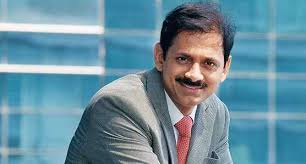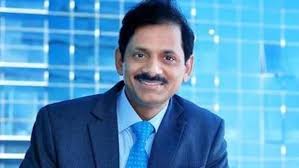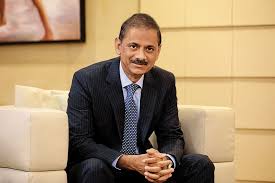As the sun sets on 2023, IDFC First Bank chief executive officer V Vaidyanathan will have plenty to cheer about when he looks back.
Retail deposits are growing at over 40%, the loan book growing within the guided range of 20-24%, asset quality remains good, net interest margin (NIM) is hovering around 6% and new businesses are seeing traction. Most importantly, the deposits are diversified, and the bank has turned into profits with PAT of over Rs 2,400 crore in FY23.
Even as everything has worked according to plan, Vaidyanathan has bet on cricket towards the second half of the year to intensify the bank’s brand visibility and awareness.
Try telling Vaidyanathan that for a bank of IDFC’s current size, coughing out Rs 235 crore (estimated, not disclosed) for three years for the title sponsorship rights for all BCCI matches for domestic and international cricket in India could have been avoided. The 56-year-old would probably look into your eyes, shrug his shoulders, and say firmly that all big companies are big brands, built over a long period of time. And that he was building a bank, not for tomorrow but for the long run.
“There is a big benefit in this. Our Top-of-Mind Awareness (TOMA) is low. A brand is a very powerful thing, so there will be a direct payoff like acceptance of products or reducing cost of funds. But we have to think long to see this payoff," he told shareholders.
Vaidyanathan has so far taken meticulous care to build IDFC First Bank as a bank with a difference. He publicly talks about ethical banking and culture as the top-most priority and says the bank has removed “complicated descriptions” and “complex calculations” for customers to understand the fees they pay. Strategically, the zero-fee proposition for customers is seen as the big brand differentiator. Outside the minimum account balance, customers are not charged for anything.
“It's not about how many people know a brand. It’s all about what people think of a brand. That’s the hardest to crack. With that power of the brand, we launched products which were genuinely clean. We didn't charge any extra penny from our customers through this or that route. So, when you have a good image and good products and then you open a branch, the flow of money is quite fantastic,” Vaidyanathan tells analysts.
IDFC First Bank’s deposit per branch is Rs 185 crore, much in line with many of the bigger banks. “I think some large private sector banks are probably better than us. They're probably in the mid-200 kind of zone, but we’re getting close in terms of deposit per branch,” Vaidyanathan told analysts.
Vaidyanathan wouldn’t rest with such a half-way positioning of the brand. In terms of size, scale and brand-build, he had ambitions to take IDFC First Bank along the route of HDFC Bank and ICICI Bank. He couldn’t also forget the brand benefit Dhirubhai Ambani’s Reliance got when it decided to sponsor the cricket World Cup in 1987, bringing the global tournament to India for the first time.
After stabilising on the deposits, loan growth, profitability and asset quality side, Vaidyanathan decided the time is right for IDFC First Bank to take the leap. For the bank’s next phase of growth, the brand had to be given a lift. More and more people needed to know that IDFC First Bank existed, and the best way to spread the reach is through the popular game of cricket.
Vaidyanathan has the habit of formulating many of his business strategies through interactions with the common people. When he asked a middle-class nurse at Hinduja Hospital on whether she had heard about IDFC First Bank, she said she was aware of HDFC Bank, SBI, IDBI Bank, IndusInd Bank and Punjab National Bank but never heard of IDFC First, a video he shared with shareholders at the annual general meeting (AGM).
This finding was backed by a brand survey which showed that IDFC First Bank's TOMA (top of mind awareness) score was only 22% even in 2023 but much short of 73-75% held by the top three banks.
"The reality is that many people still don’t know us. By sponsoring the three-year title sponsorship rights for BCCI matches for domestic and international cricket, our brand will be known by many more people and its stature will get enhanced. If we are to grow the balance sheet by 20-24% each year over a long period of time and we are also to repay our legacy high-cost borrowings, we will need to add over Rs 50-60,000 crore of deposits annually. I don’t know when but am sure that the brand will pay back in due course,” Vaidyanathan said while addressing shareholders at the AGM this year.
Forget size and scale, for now. That has run along the planned lines, but what probably makes Vaidyanathan happier is that he has worked successfully on five fundamental business requirements of the bank during the last few years. “I am not looking at scale as a measure.” he told analysts.
When we contacted Vaidyanathan to elaborate on how he had outlined the growth chart of the bank, he said he would not like to offer his comments on anything. But it wasn't difficult to trace the bank's evolution.
IDFC First Bank’s first need, due to legacy issues, was to have deposits grow faster than the assets for a long time. This will likely remain for another three years when the repayment for high-cost infrastructure bonds and refinance is completed. The legacy bonds, which stood at around Rs 30,000 crore at merger, has come down to Rs 15,000 crore, certificate of deposits (CDs) has fallen from Rs 28,000 crore to Rs 6,000 crore and “Refinance and other borrowings” from Rs 28,000 crore to Rs 20,000 crore. It’s getting clear that the bank has been raising deposits to retire borrowings.
“Once the legacy bonds are paid off, then we need to grow deposits only at 20 odd per cent, in line with the growth of the loans. We will reduce deposit interest rates further once that is paid off,” he told analysts.
The bank has recently brought down savings account interest rates to 3% for up to 1 lakh. The impact on raising deposits is yet to be seen.
Adding strength to the high deposit growth is the significant proportion of low-cost CASA (current account savings account) mix, which is stable now at 46.4% of the bank’s total deposits.
After the merger, IDFC First Bank had to also turn away from wholesale deposits and diversify its liability base. The liability profile has transformed in the last four years from wholesale to retail. The retail and wholesale deposits mix has changed from 27:73 in December 2018 to 77:23 in September 2023 out of the bank’s customer deposits of Rs 1.65 lakh crore.
“Our ability to raise deposits is so strong that we are able to fund our loan book growth comfortably and also repay the high-cost bonds as and when they are maturing. We still have another Rs 30,000 crore of repayment remaining, including Rs 15,000 crore of high cost bonds, and Rs 15,000 crore of refinance,” Vaidyanathan told analysts after announcing the fiscal second quarter results.
When IDFC Bank and Capital First merged to create IDFC First Bank in December 2018, the task high on priority list was to diversify away from the large and troubled infrastructure assets. The large exposure to infrastructure loans was inherited from IDFC which started as a domestic financial institution. After the merger, the bank has progressively run down its legacy infrastructure project financing book to 1.8% (Rs 3,356 crore) of loans & advances as of September 2023, from 19.4% (Rs 21,459 crore) in March 2019.
As of 30 September 2023, the bank has a loan book of Rs 1.83 lakh crore spread across more than 20 business lines. While mortgage-backed loans top the list with 28% of the total credit portfolio, the rest are widely distributed. “Such a diversified loan book can stand the test of time because of diversification,” Vaidyanathan tells analysts.
The third requirement was to keep the asset quality strong. Vaidyanathan has kept relentless watch on this and kept non-performing loans continuously low through stringent underwriting processes, high collection efficiency at 99.5% and reduction of concentration risk in wholesale lending. The bank's gross non-performing asset (NPA) has come down to 2.11% and net NPA to 0.68%, as of 30 September 2023. Sans infrastructure, it is even better with gross NPA at 1.69% and net NPA at 0.46%.
The bad loans on retail lending, whether secured or unsecured, is also low as IDFC First Bank lends on cash-flow assessment and has the right to debit the bank account of the borrower for repayment of EMI. The gross NPA has stayed at around 2% and net NPA at 1% for several years despite multiple stress-tests, including IL&FS crisis of 2018 and Covid-19 of 2020-21.
The fourth challenge was to lift the net interest margins (NIM), which was languishing at an annualised low of 1.9% as per the financials of 31 December 2018, due to the bank’s infrastructure DFI background. Now it is hovering around 6% and there is no conscious plan to expand it, Vaidyanathan tells analysts.
The fifth requirement for the bank staying financially healthy is to have the operating profit grow more than the loan book. As Vaidyanathan always says, this indicates that the bank is becoming increasingly profitable. For the last reporting quarter ended September 2023, the lender’s net profit grew by 35% versus the credit growth of 24%.
Vaidyanathan is also building the bank’s other businesses like credit card, gold loans and wealth management. He expects the credit card business to breakeven in FY25 and start making money in FY26. The gold loan and wealth management businesses are small at this stage but have started growing.
“We feel very confident that FY24 as a whole will be much better than FY23, and FY25 will be much stronger than FY24. And FY26, we feel will be much stronger in profitability than FY25,” he tells analysts.
For the shareholders who have seen the CEO work hard on setting the foundations right for building a large-sized bank, these are forecasts they would rather trust.







